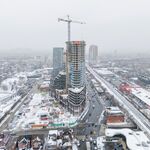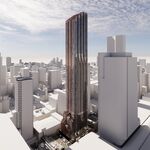When you say 'opposing' do you mean the light for the streetcar? If so then you'd be requiring the streetcar to sit through whatever the minimum red duration is, which would far exceed the time spent at a typical stop.
According to the Toronto signal timing document
@steveintoronto linked earlier, the minimum north-south phase along King Street would be roughly:
7s minimum walk
12s Flashing Don't Walk (14m @ 1.2m/s)
4s Amber
2s All-Red
__
= 25 seconds
Add in the 6 seconds of amber+all-red along King street and you're looking at a minimum of 31 seconds at a standstill before the light turns back to green. Based on my experience timing stops while riding the streetcar, a typical minor stop takes about 16 seconds, so this method would seriously increase the delays if applied there. However, at very major stops the dwell time can approach 30 seconds in which case it might be worth considering.
Also keep in mind that you can't just change the King Street light to red instantly, you need to wait for the Flashing Don't Walk first, which is pretty massive at some intersections. Depending on when the streetcar arrives during the cycle, there will be times when it is impossible to achieve your desired operation.
So while this strategy would probably be an improvement over the current setup at certain major near-side stops, it would still provide worse delays than priority optimized with a far-side stop.




